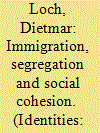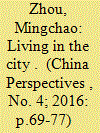|
|
|
Sort Order |
|
|
|
Items / Page
|
|
|
|
|
|
|
| Srl | Item |
| 1 |
ID:
134335


|
|
|
|
|
| Summary/Abstract |
In this article, we analyse immigrant integration against the background of German society’s social cohesion. First, we examine the integration process and policies with regard to the integration of first-generation labour migrants into the German ‘national society’ since the 1960s. Even though these ‘guest workers’ were confronted to ethnic and political exclusion owing to the so-called German integration model, they experienced socio-economic integration and, at the local level, some form of political participation. Secondly, we analyse the policies and the integration process of immigrant youth, specifically those of Turkish descent, into contemporary German society, the social cohesion of which is impeded by social exclusion and urban segregation. Our hypothesis is that – in spite of a long-standing refusal to recognise itself as an immigration country – Germany has to some extent incorporated its migrants and achieved an integration consensus, while paradoxically, national integration models in several other Western European countries are currently going through a deep crisis.
|
|
|
|
|
|
|
|
|
|
|
|
|
|
|
|
| 2 |
ID:
151566


|
|
|
|
|
| Summary/Abstract |
Based on an ethnographic survey in a primary school for the children of rural migrant workers in Hangzhou, this study examines the effects of the process of stigmatisation and the forms of internalisation associated with the “nongmingong” status of their parents. It also looks at how some of these “children of nongmingong” who go to school in the city are able to reverse this stigma. In particular, the study analyses the identity strategies deployed by students aged between ten and fourteen to deal with the stigma of their place of abode, by drawing a distinction between individual strategies (when they are alone with the investigator) and group strategies (in the presence of their peers at school).
|
|
|
|
|
|
|
|
|
|
|
|
|
|
|
|
| 3 |
ID:
182849


|
|
|
|
|
| Summary/Abstract |
This paper is interested in an emerging canon of post-millennial Indian dystopian fiction in English and the related themes of precarity and (im)purity. After introducing some recent novels and texts from the domestic Indian literary scene, the paper looks to demonstrate how precarity, (im)purity and changing ideas of India(nness) are manifested in Prayaag Akbar’s Leila, a 2017 Indian post-millennial dystopian novel in English. To focus on these particular themes, I consider the novel’s urban geography in terms of its modes of segregation, specifically how the walled sectors of the dystopian, near-future metropolis divide a city ruled over by the Repeaters and pervasive surveillance systems, whilst the Slums and the Outroads lie beyond the city limits. This focus on (im)pure involves an examination of representations of class, privilege, freedom of movement and religious affiliation. Overall, this paper is especially interested in how the dystopian as a narrative mode is harnessed in order to recount ‘precarious’ urban existence, a theme that runs through the wider body of post-millennial Indian dystopian fiction. Through discussion of the (im)purity trope and particularly through the narrative mode of the dystopian, I argue that Leila, like other recent Indian works of this genre, tangentially engages with certain socio-political themes of the second decade of the millennium such as segregation and develops ideas of India(nness) in relation to the Indian post-millennial contemporary.
|
|
|
|
|
|
|
|
|
|
|
|
|
|
|
|
|
|
|
|
|